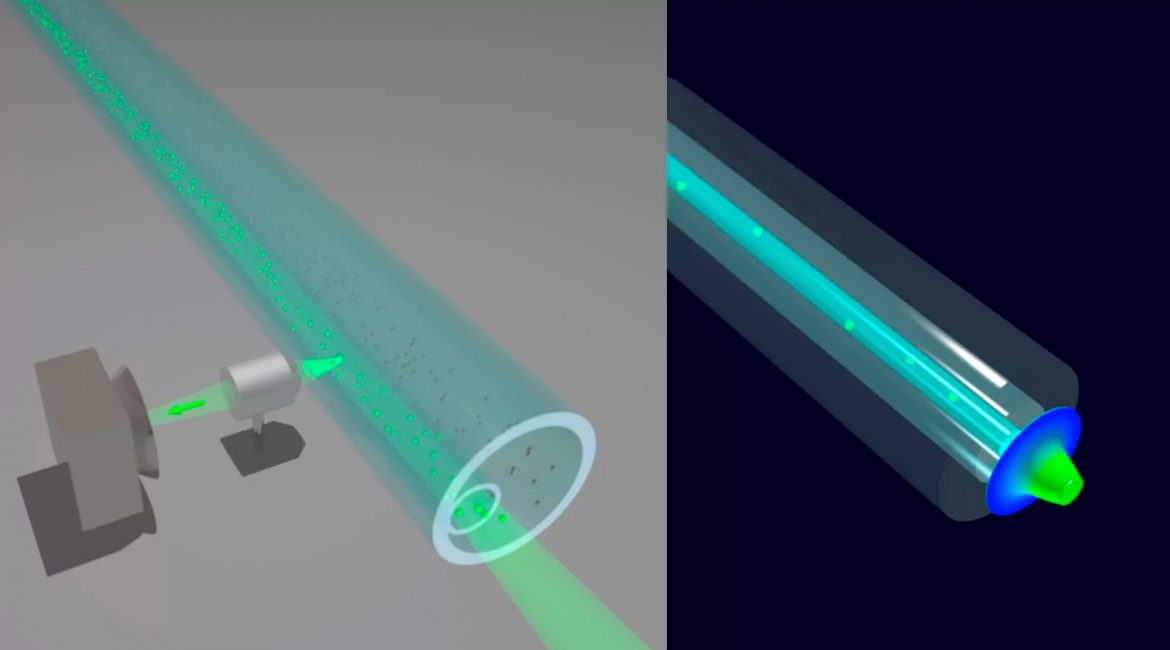| Sep 14, 2023 |
|
(Nanowerk News) Researchers at Leibniz IPHT have succeeded in contributing to significant advances in deciphering tiny nanoobjects: Using special optical fibers, they identified a new optical mode that enables uniform illumination along the entire length of the fiber, and determined the resolution limit of individual objects that could be measured with fibers. They thus lay the foundation for observing nanoparticles with unprecedented precision.
|
|
The results of their studies were published in the journals OPTICA (“Light strands: exploring flat-field modes in optofluidic fibers for tracking single nano-objects”) and Nature Communications (“Characterization of diffusing sub-10 nm nano-objects using single anti-resonant element optical fibers”).
|
 |
| Complex nanostructuring in optical fibers ensures the shaping of the new light mode (left) and allows the detection of even the smallest particles (right). (Image: Leibniz Institute of Photonic Technology)
|
|
Fiber-based methods are a promising approach to characterize fast-moving nanoparticles in pharmaceuticals, bioanalytics or materials sciences. In particular, fiber-assisted nanoparticle tracking analysis (FaNTA) enables microscopic observation of individual nanoobjects confined in microchannels of optical fibers and the precise determination of their size distribution. Scientists at Leibniz Institute of Photonic Technology (Leibniz IPHT) in Jena, Germany, are researching the possibilities of the FaNTA method and its potential for a wide variety of nanoscale applications.
|
Discovery of a new light state
|
|
As part of their research, the researchers were now able to demonstrate a new optical mode in glass fibers for the first time. This mode, identified as a light strand, which they describe in the journal OPTICA, enables extremely homogeneous and constant illumination of diffusing nanoparticles along the entire fiber.
|
|
Generating such light intensities in optical fibers requires sophisticated nanostructuring in the form of liquid-filled nanochannels in the fiber core, which can be used for real-time detection and counting of nanoobjects.
|
|
To demonstrate the formation of the new mode in fibers and its advantage for the FaNTA method, the researchers carried out experimental studies by equipping a special optical fiber with a light-conducting channel in the center of the fiber core with a diameter of 400 nanometers, filled with a liquid solution that contains diffusing nanoobjects. The fiber was manufactured by the company Heraeus Conamic. When light is coupled into the fiber, it spreads evenly along the integrated fluid channel in the form of a strand. As a result, the sample to be examined, including the nanoobjects contained therein, can be illuminated intensively and extremely homogeneously. The light scattered by individual nanoparticles allows the dynamics of the particle objects to be observed with high precision.
|
|
“The light strand shaped by the microstructured fiber design enables an unprecedented uniform illumination with constant high light intensity in optofluidic fibers, allowing extremely long and even more precise tracking of tiny objects. In this way, we prevent the intensity variations of light that typically occur at the outer edge of a nanochannel. This allows us to detect even the smallest nanoparticles consistently and thus achieve very high measurement accuracy,” explains Prof. Dr. Markus A. Schmidt, head of the Fiber Photonics Research Department at Leibniz IPHT, who uncovered the new light mode together with his team and the expert knowledge of the quartz glass specialists at Heraeus.
|
|
The knowledge gained contributes to the optimization of the FaNTA method in the detection of the smallest nanoobjects. For example, rapidly diffusing particles in the life sciences, such as viruses, their number and size distribution, as well as chemical reactions, for example when investigating the mechanisms of action of drugs, can be determined very precisely.
|
Identification of the smallest measurable nanoparticles
|
|
In addition, observations of extremely small processes and particle species are becoming increasingly important in the semiconductor industry for the production of microchips and the identification of impurities. The FaNTA method also allows these nanoscale processes in the field of materials science to be tracked microscopically with high precision.
|
|
In experimental tests with microstructured optical fibers, containing fluidic microchannels that confine tiny nanoobjects, Leibniz IPHT researchers succeeded in detecting the smallest particle ever measurable with FaNTA and thus exploring the resolution limit of the FaNTA measurement method as a whole. In their experiments, which they describe in the journal Nature Communications, they investigated mixtures with tiny particles and were able to characterize even extremely small, freely diffusing nanoparticles with a diameter of only nine nanometers with high precision. This is the smallest diameter that has so far been determined for a single nanoparticle using nanoparticle tracking analysis.
|
|
The FaNTA method thus offers the potential to open up nanoscale applications that were previously difficult to access and, for example, to be able to monitor the growth of nanoparticles or the quality control of medicines even better in the future.
|


